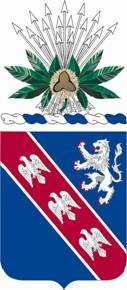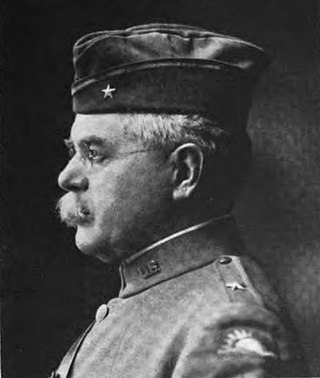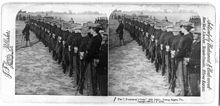
Henry Ware Lawton was a U.S. Army officer who served with distinction in the Civil War, the Apache Wars, and the Spanish–American War. He received the Medal of Honor for heroism during the American Civil War. He was the only U.S. general officer to be killed during the Philippine–American War and the first general officer of the United States killed in overseas action. The city of Lawton, Oklahoma, takes its name from General Lawton, as does a borough in the city of Havana, Cuba. Liwasang Bonifacio in downtown Manila was formerly named Plaza Lawton in his honor.

The 1st Ohio Infantry Regiment was an infantry regiment in the Union Army during the American Civil War. It served in the Western Theater in a number of campaigns and battles.

The 10th Infantry Regiment is a regiment in the United States Army first formed in 1855. Formerly a standard line regiment that served the United States in the American Civil War and again in World War II and into the Cold War, the 10th Infantry Regiment is now a garrison regiment housing training cadre and trainees undergoing Basic Combat Training with the United States Army.
The 4th Ohio Infantry Regiment was an infantry regiment in the Union Army during the American Civil War. It served in the Eastern Theater in a number of campaigns and battles, but perhaps is most noted for its actions in helping secure Cemetery Hill during the Battle of Gettysburg.

The 371st Sustainment Brigade is an Ohio Army National Guard Sustainment Brigade. It is based out of Springfield, Ohio. The 371st Sustainment Brigade is made up of the 371st Special Troops Battalion and the 112th Transportation Battalion.

The 14th Ohio Infantry Regiment was an infantry regiment in the Union Army during the American Civil War.
The 15th Ohio Infantry Regiment was an infantry regiment in the Union Army during the American Civil War.
The Second Army Corps was a unit of the United States Army raised for the Spanish–American War. A defining event of the Spanish–American War was the typhoid fever epidemic of July to November 1898. The Army consequently undertook a series of mass-retreats and attempted evasions. The Typhoid Board concluded that only one of the five army corps stricken with epidemic typhoid succeeded in suppressing the disease actively, the 2nd Army Corps. In the wake of two fruitless relocations and months of casualties, commanders finally managed to impose an effective latrine-policy. A three-part strategy of draconian defecation-management, mass-disinfection, and flight received the Typhoid Board's imprimatur as the principal, recommended method for suppressing existing epidemics.
The 77th Ohio Infantry Regiment, sometimes 77th Ohio Volunteer Infantry was an infantry regiment in the Union Army during the American Civil War.
The 86th Ohio Infantry Regiment, sometimes 86th Ohio Volunteer Infantry was an infantry regiment in the Union Army during the American Civil War.
The 108th Ohio Infantry Regiment, sometimes 108th Ohio Volunteer Infantry was an infantry regiment in the Union Army during the American Civil War.

The 116th Ohio Infantry Regiment, sometimes 116th Ohio Volunteer Infantry was an infantry regiment in the Union Army during the American Civil War.
The 128th Ohio Infantry Regiment, sometimes 128th Ohio Volunteer Infantry was an infantry regiment in the Union Army during the American Civil War.
The 130th Ohio Infantry Regiment, sometimes 130th Ohio Volunteer Infantry was an infantry regiment in the Union Army during the American Civil War. It was originally organized as the 1st Ohio National Guard.

The 146th Field Artillery Regiment is a field artillery regiment of the Army National Guard first Constituted in 1886 as the 1st, and 2nd Regiments of Infantry.

The 113th Infantry Regiment is an Infantry regiment of the New Jersey Army National Guard. It is one of several National Guard units with colonial roots and campaign credit for the War of 1812.

The 147th Regiment (Regional Training Institute) is a training regiment of the Ohio Army National Guard. Previously known as the 147th Infantry Regiment and the 6th Ohio Infantry, it has served in several American wars as a combat infantry unit, but now maintains the Ohio Regional Training Institute (RTI) in Columbus, Ohio. Its regimental motto is Cargoneek Guyoxim, which is Chippewa Indian for "Always Ready." The lineage of the regiment is carried by the 174th Air Defense Artillery Regiment.
The Detroit Light Guard is a military formation in the United States Army, Michigan Army National Guard that has served in many functions since its creation in 1830, including state duties, and even overseas combat. It is survived today in the US Army's 1225th Corps Support Battalion. The Light Guard's nickname, the "Tigers," is the origin of the name of the Detroit Tigers baseball team.
The 2nd Massachusetts Volunteer Infantry Regiment was an infantry unit of the United States Army, mustered into Federal service during the Spanish–American War.

Edward Vollrath was an American attorney and military officer from Bucyrus, Ohio. A veteran of the Spanish–American War, Pancho Villa Expedition, and World War I, he was most notable for his command of the 8th Ohio Volunteer Infantry in Cuba during the war with Spain and on the Mexican border during the Villa expedition, and his First World War command of the 82nd Infantry Brigade, a unit of the 41st Division.










